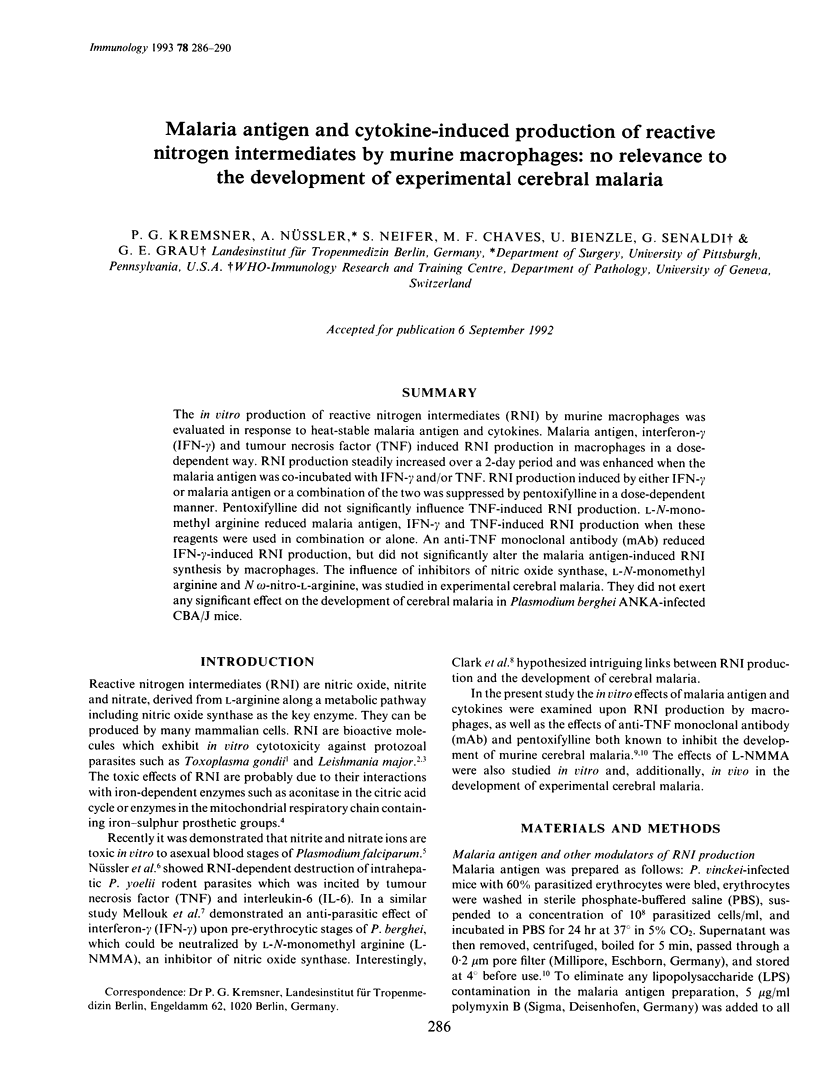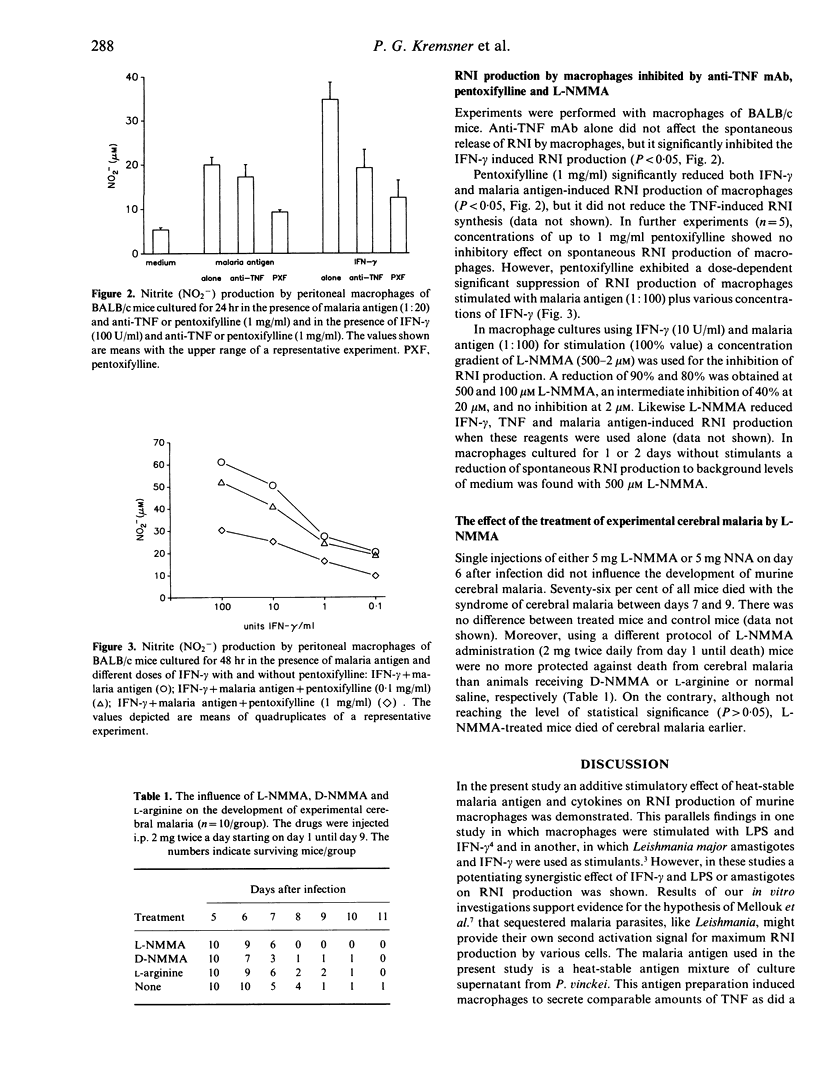Abstract
The in vitro production of reactive nitrogen intermediates (RNI) by murine macrophages was evaluated in response to heat-stable malaria antigen and cytokines. Malaria antigen, interferon-gamma (IFN-gamma) and tumour necrosis factor (TNF) induced RNI production in macrophages in a dose-dependent way. RNI production steadily increased over a 2-day period and was enhanced when the malaria antigen was co-incubated with IFN-gamma and/or TNF. RNI production induced by either IFN-gamma or malaria antigen or a combination of the two was suppressed by pentoxifylline in a dose-dependent manner. Pentoxifylline did not significantly influence TNF-induced RNI production. L-N-monomethyl arginine reduced malaria antigen, IFN-gamma and TNF-induced RNI production when these reagents were used in combination or alone. An anti-TNF monoclonal antibody (mAb) reduced IFN-gamma-induced RNI production, but did not significantly alter the malaria antigen-induced RNI synthesis by macrophages. The influence of inhibitors of nitric oxide synthase, L-N-monomethyl arginine and N omega-nitro-L-arginine, was studied in experimental cerebral malaria. They did not exert any significant effect on the development of cerebral malaria in Plasmodium berghei ANKA-infected CBA/J mice.
Full text
PDF




Selected References
These references are in PubMed. This may not be the complete list of references from this article.
- Adams L. B., Hibbs J. B., Jr, Taintor R. R., Krahenbuhl J. L. Microbiostatic effect of murine-activated macrophages for Toxoplasma gondii. Role for synthesis of inorganic nitrogen oxides from L-arginine. J Immunol. 1990 Apr 1;144(7):2725–2729. [PubMed] [Google Scholar]
- Bate C. A., Taverne J., Karunaweera N. D., Mendis K. N., Kwiatkowski D., Playfair J. H. Serological relationship of tumor necrosis factor-inducing exoantigens of Plasmodium falciparum and Plasmodium vivax. Infect Immun. 1992 Mar;60(3):1241–1243. doi: 10.1128/iai.60.3.1241-1243.1992. [DOI] [PMC free article] [PubMed] [Google Scholar]
- Bate C. A., Taverne J., Playfair J. H. Soluble malarial antigens are toxic and induce the production of tumour necrosis factor in vivo. Immunology. 1989 Apr;66(4):600–605. [PMC free article] [PubMed] [Google Scholar]
- Billiar T. R., Curran R. D., Harbrecht B. G., Stuehr D. J., Demetris A. J., Simmons R. L. Modulation of nitrogen oxide synthesis in vivo: NG-monomethyl-L-arginine inhibits endotoxin-induced nitrate/nitrate biosynthesis while promoting hepatic damage. J Leukoc Biol. 1990 Dec;48(6):565–569. doi: 10.1002/jlb.48.6.565. [DOI] [PubMed] [Google Scholar]
- Clark I. A., Hunt N. H., Butcher G. A., Cowden W. B. Inhibition of murine malaria (Plasmodium chabaudi) in vivo by recombinant interferon-gamma or tumor necrosis factor, and its enhancement by butylated hydroxyanisole. J Immunol. 1987 Nov 15;139(10):3493–3496. [PubMed] [Google Scholar]
- Clark I. A., Rockett K. A., Cowden W. B. Proposed link between cytokines, nitric oxide and human cerebral malaria. Parasitol Today. 1991 Aug;7(8):205–207. doi: 10.1016/0169-4758(91)90142-b. [DOI] [PubMed] [Google Scholar]
- Curfs J. H., Schetters T. P., Hermsen C. C., Jerusalem C. R., van Zon A. A., Eling W. M. Immunological aspects of cerebral lesions in murine malaria. Clin Exp Immunol. 1989 Jan;75(1):136–140. [PMC free article] [PubMed] [Google Scholar]
- Curfs J. H., van der Meer J. W., Sauerwein R. W., Eling W. M. Low dosages of interleukin 1 protect mice against lethal cerebral malaria. J Exp Med. 1990 Nov 1;172(5):1287–1291. doi: 10.1084/jem.172.5.1287. [DOI] [PMC free article] [PubMed] [Google Scholar]
- Curran R. D., Billiar T. R., Stuehr D. J., Ochoa J. B., Harbrecht B. G., Flint S. G., Simmons R. L. Multiple cytokines are required to induce hepatocyte nitric oxide production and inhibit total protein synthesis. Ann Surg. 1990 Oct;212(4):462–471. doi: 10.1097/00000658-199010000-00009. [DOI] [PMC free article] [PubMed] [Google Scholar]
- Drapier J. C., Hibbs J. B., Jr Differentiation of murine macrophages to express nonspecific cytotoxicity for tumor cells results in L-arginine-dependent inhibition of mitochondrial iron-sulfur enzymes in the macrophage effector cells. J Immunol. 1988 Apr 15;140(8):2829–2838. [PubMed] [Google Scholar]
- Falanga P. B., Butcher E. C. Late treatment with anti-LFA-1 (CD11a) antibody prevents cerebral malaria in a mouse model. Eur J Immunol. 1991 Sep;21(9):2259–2263. doi: 10.1002/eji.1830210938. [DOI] [PubMed] [Google Scholar]
- Grau G. E., Fajardo L. F., Piguet P. F., Allet B., Lambert P. H., Vassalli P. Tumor necrosis factor (cachectin) as an essential mediator in murine cerebral malaria. Science. 1987 Sep 4;237(4819):1210–1212. doi: 10.1126/science.3306918. [DOI] [PubMed] [Google Scholar]
- Grau G. E., Heremans H., Piguet P. F., Pointaire P., Lambert P. H., Billiau A., Vassalli P. Monoclonal antibody against interferon gamma can prevent experimental cerebral malaria and its associated overproduction of tumor necrosis factor. Proc Natl Acad Sci U S A. 1989 Jul;86(14):5572–5574. doi: 10.1073/pnas.86.14.5572. [DOI] [PMC free article] [PubMed] [Google Scholar]
- Grau G. E., Piguet P. F., Vassalli P., Lambert P. H. Tumor-necrosis factor and other cytokines in cerebral malaria: experimental and clinical data. Immunol Rev. 1989 Dec;112:49–70. doi: 10.1111/j.1600-065x.1989.tb00552.x. [DOI] [PubMed] [Google Scholar]
- Green S. J., Meltzer M. S., Hibbs J. B., Jr, Nacy C. A. Activated macrophages destroy intracellular Leishmania major amastigotes by an L-arginine-dependent killing mechanism. J Immunol. 1990 Jan 1;144(1):278–283. [PubMed] [Google Scholar]
- Kremsner P. G., Grundmann H., Neifer S., Sliwa K., Sahlmüller G., Hegenscheid B., Bienzle U. Pentoxifylline prevents murine cerebral malaria. J Infect Dis. 1991 Sep;164(3):605–608. doi: 10.1093/infdis/164.3.605. [DOI] [PubMed] [Google Scholar]
- Kremsner P. G., Neifer S., Chaves M. F., Rudolph R., Bienzle U. Interferon-gamma induced lethality in the late phase of Plasmodium vinckei malaria despite effective parasite clearance by chloroquine. Eur J Immunol. 1992 Nov;22(11):2873–2878. doi: 10.1002/eji.1830221118. [DOI] [PubMed] [Google Scholar]
- Kremsner P. G., Neifer S., Schermuck S., Chaves M. F., Sliwa K., Bienzle U. Interferon-gamma enhances the effect of antimalarial chemotherapy in murine Plasmodium vinckei malaria. J Infect Dis. 1991 May;163(5):1161–1163. doi: 10.1093/infdis/163.5.1161. [DOI] [PubMed] [Google Scholar]
- Kubes P., Suzuki M., Granger D. N. Nitric oxide: an endogenous modulator of leukocyte adhesion. Proc Natl Acad Sci U S A. 1991 Jun 1;88(11):4651–4655. doi: 10.1073/pnas.88.11.4651. [DOI] [PMC free article] [PubMed] [Google Scholar]
- Liew F. Y., Li Y., Millott S. Tumor necrosis factor-alpha synergizes with IFN-gamma in mediating killing of Leishmania major through the induction of nitric oxide. J Immunol. 1990 Dec 15;145(12):4306–4310. [PubMed] [Google Scholar]
- Mellouk S., Green S. J., Nacy C. A., Hoffman S. L. IFN-gamma inhibits development of Plasmodium berghei exoerythrocytic stages in hepatocytes by an L-arginine-dependent effector mechanism. J Immunol. 1991 Jun 1;146(11):3971–3976. [PubMed] [Google Scholar]
- Nava E., Palmer R. M., Moncada S. Inhibition of nitric oxide synthesis in septic shock: how much is beneficial? Lancet. 1991 Dec 21;338(8782-8783):1555–1557. doi: 10.1016/0140-6736(91)92375-c. [DOI] [PubMed] [Google Scholar]
- Nussler A., Pied S., Goma J., Rénia L., Miltgen F., Grau G. E., Mazier D. TNF inhibits malaria hepatic stages in vitro via synthesis of IL-6. Int Immunol. 1991 Apr;3(4):317–321. doi: 10.1093/intimm/3.4.317. [DOI] [PubMed] [Google Scholar]
- Nüssler A., Drapier J. C., Rénia L., Pied S., Miltgen F., Gentilini M., Mazier D. L-arginine-dependent destruction of intrahepatic malaria parasites in response to tumor necrosis factor and/or interleukin 6 stimulation. Eur J Immunol. 1991 Jan;21(1):227–230. doi: 10.1002/eji.1830210134. [DOI] [PubMed] [Google Scholar]
- Palmer R. M., Ferrige A. G., Moncada S. Nitric oxide release accounts for the biological activity of endothelium-derived relaxing factor. Nature. 1987 Jun 11;327(6122):524–526. doi: 10.1038/327524a0. [DOI] [PubMed] [Google Scholar]
- Polder T. W., Jerusalem C. R., Eling W. M. Morphological characteristics of intracerebral arterioles in clinical (Plasmodium falciparum) and experimental (Plasmodium berghei) cerebral malaria. J Neurol Sci. 1991 Jan;101(1):35–46. doi: 10.1016/0022-510x(91)90016-z. [DOI] [PubMed] [Google Scholar]
- Rockett K. A., Awburn M. M., Cowden W. B., Clark I. A. Killing of Plasmodium falciparum in vitro by nitric oxide derivatives. Infect Immun. 1991 Sep;59(9):3280–3283. doi: 10.1128/iai.59.9.3280-3283.1991. [DOI] [PMC free article] [PubMed] [Google Scholar]
- Sliwa K., Grundmann H. J., Neifer S., Chaves M. F., Sahlmüller G., Blitstein-Willinger E., Bienzle U., Kremsner P. G. Prevention of murine cerebral malaria by a stable prostacyclin analog. Infect Immun. 1991 Oct;59(10):3846–3848. doi: 10.1128/iai.59.10.3846-3848.1991. [DOI] [PMC free article] [PubMed] [Google Scholar]


